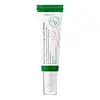What's inside
What's inside
 Key Ingredients
Key Ingredients

 Benefits
Benefits

 Concerns
Concerns

No concerns
 Ingredients Side-by-side
Ingredients Side-by-side

Water
Skin ConditioningCaprylic/Capric Triglyceride
MaskingGlycerin
HumectantButylene Glycol
HumectantCyclopentasiloxane
EmollientGlyceryl Polymethacrylate
Pyrus Malus Fruit Extract
Skin ConditioningPEG-8
HumectantGlyceryl Stearate
EmollientPEG-100 Stearate
Cetearyl Alcohol
EmollientSodium Polyacryloyldimethyl Taurate
Emulsion StabilisingSaccharide Isomerate
HumectantCaprylyl Glycol
EmollientOlea Europaea Leaf Powder
AbrasiveAvena Sativa Bran Extract
AbrasiveHydrogenated Polydecene
EmollientPolysorbate 60
EmulsifyingCetyl Alcohol
EmollientZingiber Officinale Root Extract
MaskingMenthoxypropanediol
MaskingHoney
HumectantAminomethyl Propanol
BufferingCamellia Sinensis Leaf Powder
ExfoliatingAcrylates/C10-30 Alkyl Acrylate Crosspolymer
Emulsion StabilisingEthylhexylglycerin
Skin ConditioningTocopheryl Acetate
AntioxidantAllantoin
Skin ConditioningKaolin
AbrasiveHexylene Glycol
EmulsifyingButeth-3
SolventTrideceth-10
CleansingBenzophenone-4
UV AbsorberSodium Benzotriazolyl Butylphenol Sulfonate
UV AbsorberCocos Nucifera Fruit Extract
EmollientSodium Hyaluronate
HumectantAlcohol
AntimicrobialTris(Tetramethylhydroxypiperidinol)Citrate
StabilisingParfum
MaskingCoumarin
PerfumingLinalool
PerfumingTetrahexyldecyl Ascorbate
AntioxidantDisodium EDTA
Sodium Benzoate
MaskingPotassium Sorbate
PreservativePhenoxyethanol
PreservativeWater, Caprylic/Capric Triglyceride, Glycerin, Butylene Glycol, Cyclopentasiloxane, Glyceryl Polymethacrylate, Pyrus Malus Fruit Extract, PEG-8, Glyceryl Stearate, PEG-100 Stearate, Cetearyl Alcohol, Sodium Polyacryloyldimethyl Taurate, Saccharide Isomerate, Caprylyl Glycol, Olea Europaea Leaf Powder, Avena Sativa Bran Extract, Hydrogenated Polydecene, Polysorbate 60, Cetyl Alcohol, Zingiber Officinale Root Extract, Menthoxypropanediol, Honey, Aminomethyl Propanol, Camellia Sinensis Leaf Powder, Acrylates/C10-30 Alkyl Acrylate Crosspolymer, Ethylhexylglycerin, Tocopheryl Acetate, Allantoin, Kaolin, Hexylene Glycol, Buteth-3, Trideceth-10, Benzophenone-4, Sodium Benzotriazolyl Butylphenol Sulfonate, Cocos Nucifera Fruit Extract, Sodium Hyaluronate, Alcohol, Tris(Tetramethylhydroxypiperidinol)Citrate, Parfum, Coumarin, Linalool, Tetrahexyldecyl Ascorbate, Disodium EDTA, Sodium Benzoate, Potassium Sorbate, Phenoxyethanol
Water
Skin ConditioningGlycerin
HumectantNiacinamide
SmoothingSodium Hyaluronate
HumectantPropanediol
SolventErythritol
HumectantButylene Glycol
HumectantSqualane
EmollientOryza Sativa Bran Extract
Skin ConditioningCalendula Officinalis Flower Extract
MaskingCarica Papaya Fruit Extract
Skin ConditioningHippophae Rhamnoides Fruit Extract
Skin ConditioningMalpighia Glabra Fruit Extract
Skin ConditioningPolyglyceryl-10 Laurate
Skin ConditioningChlorphenesin
AntimicrobialArginine
MaskingEthylhexylglycerin
Skin ConditioningCarbomer
Emulsion StabilisingGlutathione
1,2-Hexanediol
Skin ConditioningHydroxypropyl Cyclodextrin
MaskingDisodium EDTA
Hydroxyethylcellulose
Emulsion StabilisingAllantoin
Skin ConditioningRosmarinus Officinalis Leaf Oil
MaskingWater, Glycerin, Niacinamide, Sodium Hyaluronate, Propanediol, Erythritol, Butylene Glycol, Squalane, Oryza Sativa Bran Extract, Calendula Officinalis Flower Extract, Carica Papaya Fruit Extract, Hippophae Rhamnoides Fruit Extract, Malpighia Glabra Fruit Extract, Polyglyceryl-10 Laurate, Chlorphenesin, Arginine, Ethylhexylglycerin, Carbomer, Glutathione, 1,2-Hexanediol, Hydroxypropyl Cyclodextrin, Disodium EDTA, Hydroxyethylcellulose, Allantoin, Rosmarinus Officinalis Leaf Oil
 Reviews
Reviews

Ingredients Explained
These ingredients are found in both products.
Ingredients higher up in an ingredient list are typically present in a larger amount.
Allantoin is a soothing ingredient known for its protective and moisturizingg properties. Because of this, it is often added to products with strong active ingredients.
Studies show higher concentrations of this ingredient can promote wound healing.
Though it can be derived from the comfrey plant, allantoin is produced synthetically for cosmetic products to ensure purity.
Learn more about AllantoinButylene Glycol (or BG) is used within cosmetic products for a few different reasons:
Overall, Butylene Glycol is a safe and well-rounded ingredient that works well with other ingredients.
Though this ingredient works well with most skin types, some people with sensitive skin may experience a reaction such as allergic rashes, closed comedones, or itchiness.
Learn more about Butylene GlycolDisodium EDTA plays a role in making products more stable by aiding other preservatives.
It is a chelating agent, meaning it neutralizes metal ions that may be found in a product.
Disodium EDTA is a salt of edetic acid and is found to be safe in cosmetic ingredients.
Learn more about Disodium EDTAEthylhexylglycerin (we can't pronounce this either) is commonly used as a preservative and skin softener. It is derived from glyceryl.
You might see Ethylhexylglycerin often paired with other preservatives such as phenoxyethanol. Ethylhexylglycerin has been found to increase the effectiveness of these other preservatives.
Glycerin is already naturally found in your skin. It helps moisturize and protect your skin.
A study from 2016 found glycerin to be more effective as a humectant than AHAs and hyaluronic acid.
As a humectant, it helps the skin stay hydrated by pulling moisture to your skin. The low molecular weight of glycerin allows it to pull moisture into the deeper layers of your skin.
Hydrated skin improves your skin barrier; Your skin barrier helps protect against irritants and bacteria.
Glycerin has also been found to have antimicrobial and antiviral properties. Due to these properties, glycerin is often used in wound and burn treatments.
In cosmetics, glycerin is usually derived from plants such as soybean or palm. However, it can also be sourced from animals, such as tallow or animal fat.
This ingredient is organic, colorless, odorless, and non-toxic.
Glycerin is the name for this ingredient in American English. British English uses Glycerol/Glycerine.
Learn more about GlycerinSodium Hyaluronate is hyaluronic acid's salt form. It is commonly derived from the sodium salt of hyaluronic acid.
Like hyaluronic acid, it is great at holding water and acts as a humectant. This makes it a great skin hydrating ingredient.
Sodium Hyaluronate is naturally occurring in our bodies and is mostly found in eye fluid and joints.
These are some other common types of Hyaluronic Acid:
Learn more about Sodium HyaluronateWater. It's the most common cosmetic ingredient of all. You'll usually see it at the top of ingredient lists, meaning that it makes up the largest part of the product.
So why is it so popular? Water most often acts as a solvent - this means that it helps dissolve other ingredients into the formulation.
You'll also recognize water as that liquid we all need to stay alive. If you see this, drink a glass of water. Stay hydrated!
Learn more about Water